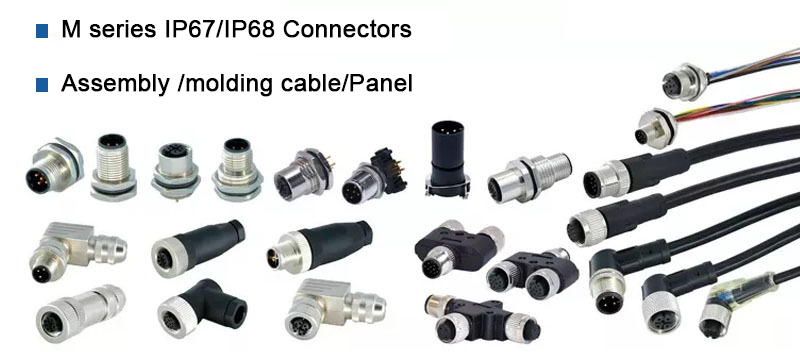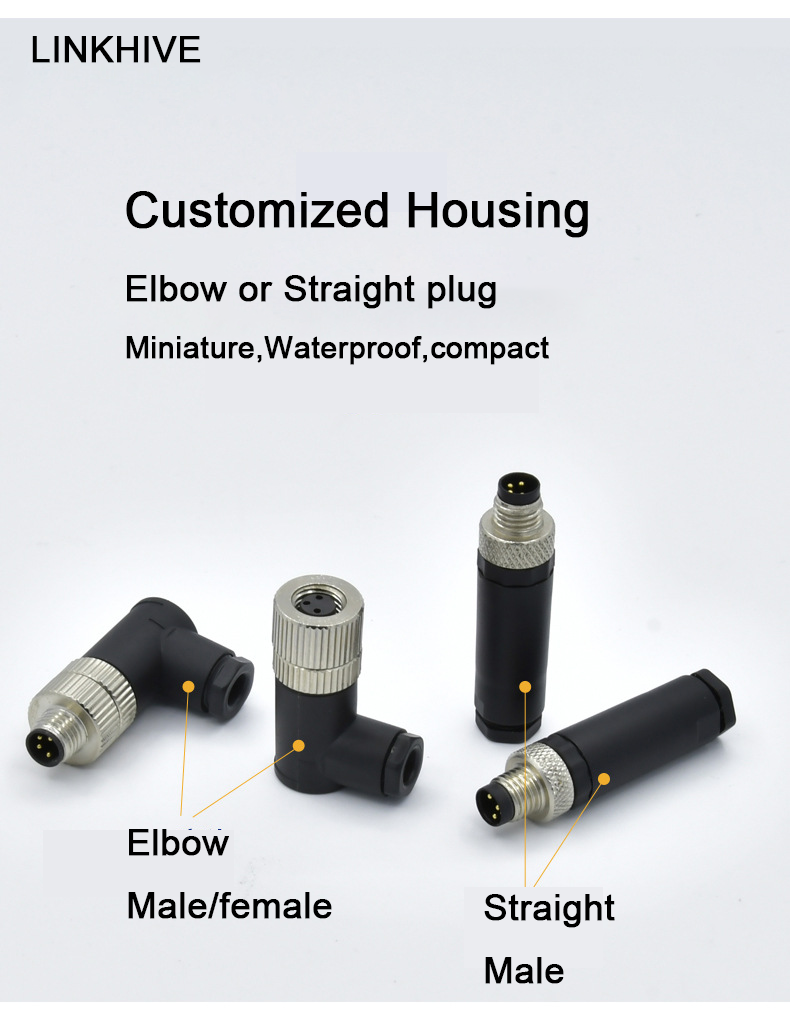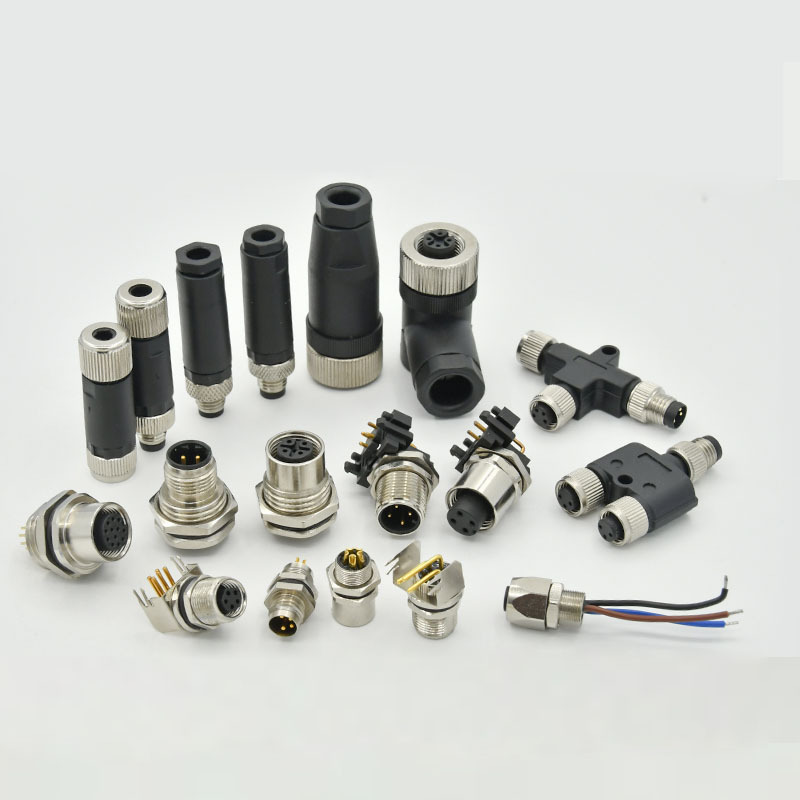As a widely used connector in the field of industrial automation, the M8 connector has become a core component of many devices and systems with its compact size, reliable electrical connection and rugged structure. With its small size and high protection, the M8 connector is widely used in electrical connections between sensors, actuators, controllers and other automation equipment.
When selecting an M8 connector, in addition to paying attention to its own design, application scenarios and rated parameters, another key factor is the matching wire specifications. It is crucial to correctly select the wire specifications that match the M8 connector, because this directly affects the electrical performance, safety and long-term stability of the connector.
This article will focus on the topic of "What wire specifications does the M8 connector use?", answering in detail the relationship between the M8 connector and the wire specifications, and analyzing how to select the appropriate wire specifications according to different application requirements.

What is an M8 connector?
The M8 connector is an industrial connector that usually has an outer diameter of 8 mm and is designed to connect electrical signals, data or power. Its main features are compactness, ruggedness, and high protection level. It is often used in automation equipment, sensors, photoelectric switches, pressure sensors, temperature sensors and other fields. The common connection method of M8 connector is threaded plug and socket connection, which ensures stable and reliable connection. The interface of M8 connector is usually 3, 4, 5 or 8 pins, which is used to connect signal lines or power lines to meet the needs of different devices.
Compared with its compact structure, M8 connector has strong anti-interference ability and protection, and can resist the influence of external factors such as dust, moisture, vibration in industrial environment. The design of M8 connector enables it to adapt to a variety of environmental conditions, such as high humidity, high temperature or harsh mechanical environment, so it is widely used in the field of automation.

What specifications of wires are used for M8 connectors?
In the application of M8 connectors, the selection of wires plays a vital role. The wires adapted to M8 connectors need to meet certain specifications, which are mainly related to factors such as voltage, current, conductor material, outer sheath material and protection level. The correct selection of wire specifications can not only ensure electrical performance, but also ensure the long-term stable operation of equipment.
1. Rated voltage and rated current
M8 connectors are usually suitable for low-voltage electrical systems, and their rated voltage is usually 30V, 60V or 250V. When selecting wires, the rated voltage of the wires must match the rated voltage of the M8 connectors. If the rated voltage of the wires is too low, it may cause the wires to overheat, age, or even short circuit or electrical failure. Therefore, the voltage value that the selected wires need to withstand should be higher than the rated voltage of the M8 connectors.
Rated current is an important parameter when matching M8 connectors with wires. The rated current of M8 connectors is usually between 1A and 4A, which means that the rated current of the selected wires must be able to carry current within this range. Too low rated current will cause the wires to be overloaded, overheated, and may even cause safety hazards such as fire; while too high rated current will increase the cost and size of the wires. Therefore, wires that match the current requirements of the M8 connectors should be selected.
2. Wire conductor material
The conductor material of the wire is crucial to the electrical performance of the wire, especially in high frequency, long-distance transmission, and anti-interference. Common wire conductor materials are copper and aluminum. Copper conductors are widely used in industrial automation equipment due to their good electrical conductivity and corrosion resistance.
● Copper conductor: Copper has a high electrical conductivity, so copper conductors are the first choice in applications that require stable signal transmission and low resistance. Copper conductor wires have good electrical conductivity and are suitable for applications that require higher electrical performance and lower voltage drop.
● Aluminum conductor: Although aluminum has a lower electrical conductivity than copper, it is relatively cheap and suitable for applications that do not require high electrical conductivity. If the current requirement in the M8 connector application scenario is low, aluminum conductor wires can be used as an economical choice.
When selecting wires, appropriate conductor materials should be selected according to specific application requirements to ensure that the wires have low resistance and good conductivity during operation, thereby improving the efficiency and stability of the electrical system.
3. Wire outer sheath material
M8 connectors are often used in industrial environments, and equipment needs to be frequently exposed to harsh conditions such as high humidity, high temperature, and chemical corrosion. In order to protect the wires from damage from the external environment, the outer sheath material of the wires is particularly important. Common wire sheath materials include PVC, PUR, TPE, etc.
● PVC (polyvinyl chloride): PVC is a common wire sheath material with good wear resistance, corrosion resistance and insulation performance. It is suitable for most general environments, but its performance may be reduced in extremely high or low temperature environments.
● PUR (polyurethane): PUR is a wire sheath material with high mechanical strength and corrosion resistance, and is often used in demanding industrial environments. PUR cables have strong oil resistance, UV resistance, and wear resistance, so they can provide better protection when used in harsh environments.
● TPE (thermoplastic elastomer): TPE materials have higher flexibility and low temperature resistance, and are suitable for use in low temperature environments. The advantage of TPE cable in flexibility makes it very suitable for some occasions that require bending and flexible wiring.
Selecting the appropriate wire sheath material can greatly improve the durability of the M8 connector system, especially in some environments with high humidity, chemical corrosion or high mechanical impact. High-quality outer sheaths can effectively extend the service life of wires and connectors.
4. Wire diameter
The wire diameter used by the M8 connector should be determined according to the size of the required transmission current. The larger the wire diameter, the stronger the current carrying capacity and the lower the resistance of the wire, which is suitable for high current transmission. Generally, the wire diameter used by the M8 connector is smaller and suitable for low current transmission.
The wire diameter of the wire is generally expressed in AWG (American Wire Gauge) or millimeters (mm²). When selecting wires, common specifications include 0.25mm², 0.5mm², 1.0mm², 1.5mm², etc. These specifications of wires can adapt to the different current requirements of the M8 connector.
For example, if the rated current of the M8 connector is 2A, 0.25mm² or 0.5mm² wires are usually selected; if the current demand is larger, a larger wire size is required. Selecting the appropriate wire diameter can ensure that the wire does not overheat when transmitting current and avoid aging or damage to the wire.

How to correctly match the M8 connector with the wire?
The correct wire specification selection can ensure the reliable operation of the M8 connector in the electrical system. For the matching of the M8 connector and the wire, the following points need special attention:
● Matching rated current and wire specification: The appropriate wire specification should be selected according to the rated current of the M8 connector. The rated current of the wire cannot be lower than the rated current of the M8 connector, and the wire diameter and conductor material should be selected to match it.
● Consider the length of the wire: The length of the wire will affect the voltage drop, so when selecting the wire, it is necessary to calculate the appropriate wire diameter according to the length and current requirements of the system. Longer cables require wires with larger wire diameters to reduce voltage drop and power loss.
● Consideration of environmental factors: Select appropriate sheath materials according to the environment where the wire is located to prevent the wire from being damaged in harsh environments. PUR and TPE are wire sheath materials suitable for use in complex environments, which can withstand greater mechanical shock, chemical corrosion and low temperature.
● Avoid overload: The selected wire should be able to carry the current requirements of the system to avoid fire or electrical failure caused by overload of the wire. If the wire gauge is too small and the current exceeds its rating, the wire may overheat, causing safety hazards.

At LINKHIVE, we deliver precision connectors that meet the highest standards of quality and reliability. With over 2,000 standard products and extensive custom options, we cater to ranging industries from medical devices to aerospace and telecommunications. As a leading manufacturer and supplier, we offer connectors at affordable prices, wholesale rates, and discounts for bulk purchases. With our commitment to excellence and customer satisfaction, LINKHIVE is the ideal choice for purchasing connectors that meet your unique needs at low prices. Get in touch with us today for competitive quotes and connector customized solutions.


